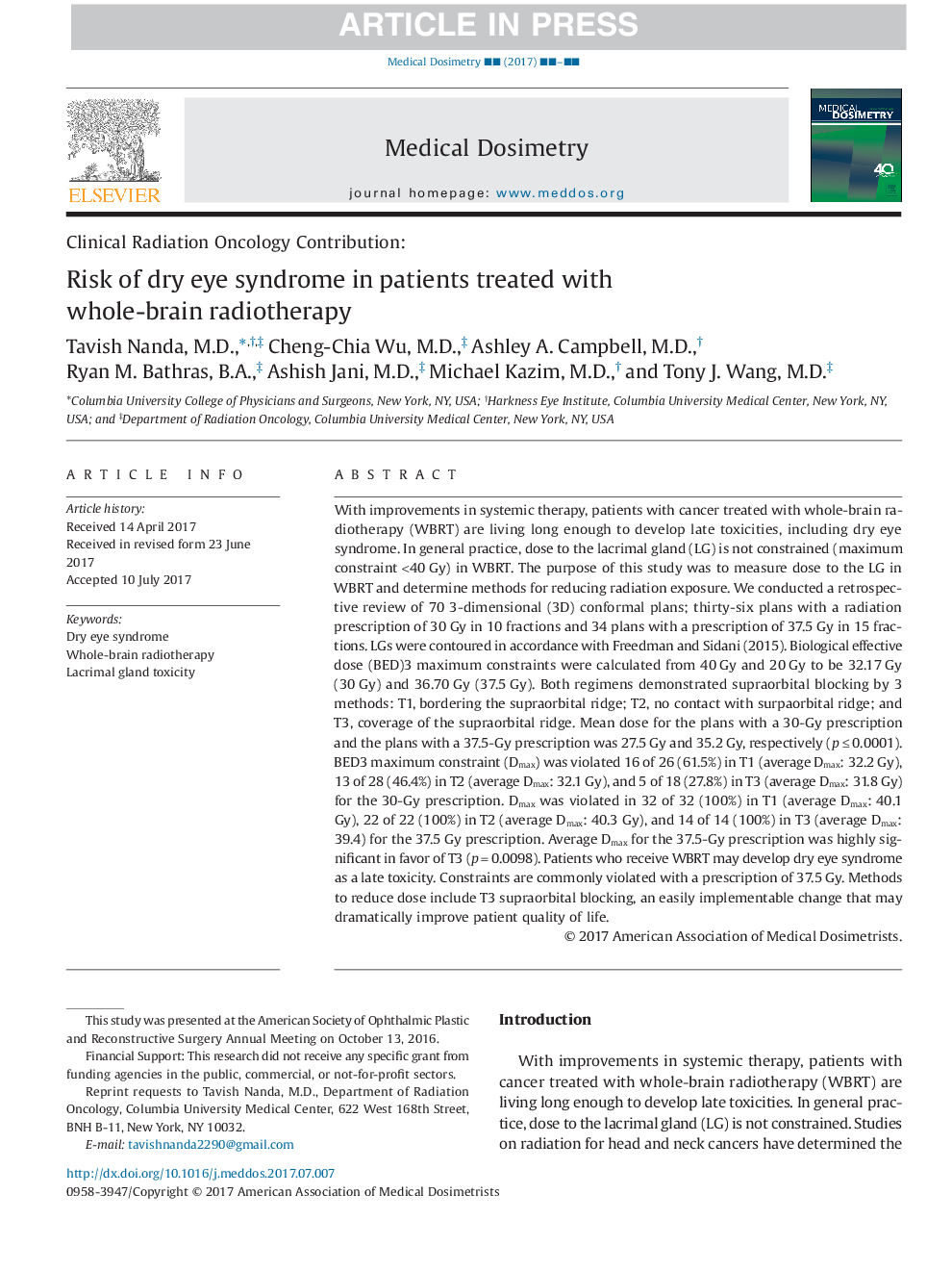| کد مقاله | کد نشریه | سال انتشار | مقاله انگلیسی | نسخه تمام متن |
|---|---|---|---|---|
| 8248342 | 1533328 | 2017 | 6 صفحه PDF | دانلود رایگان |
عنوان انگلیسی مقاله ISI
Risk of dry eye syndrome in patients treated with whole-brain radiotherapy
ترجمه فارسی عنوان
خطر سندرم چشم خشک در بیماران تحت درمان با رادیوتراپی کل مغز
دانلود مقاله + سفارش ترجمه
دانلود مقاله ISI انگلیسی
رایگان برای ایرانیان
کلمات کلیدی
سندرم خشکی چشم، پرتودرمانی کل مغز، مسمومیت غدد لنفاوی،
موضوعات مرتبط
مهندسی و علوم پایه
فیزیک و نجوم
تشعشع
چکیده انگلیسی
With improvements in systemic therapy, patients with cancer treated with whole-brain radiotherapy (WBRT) are living long enough to develop late toxicities, including dry eye syndrome. In general practice, dose to the lacrimal gland (LG) is not constrained (maximum constraint <40âGy) in WBRT. The purpose of this study was to measure dose to the LG in WBRT and determine methods for reducing radiation exposure. We conducted a retrospective review of 70 3-dimensional (3D) conformal plans; thirty-six plans with a radiation prescription of 30 Gy in 10 fractions and 34 plans with a prescription of 37.5 Gy in 15 fractions. LGs were contoured in accordance with Freedman and Sidani (2015). Biological effective dose (BED)3 maximum constraints were calculated from 40âGy and 20âGy to be 32.17âGy (30âGy) and 36.70âGy (37.5âGy). Both regimens demonstrated supraorbital blocking by 3 methods: T1, bordering the supraorbital ridge; T2, no contact with supraorbital ridge; and T3, coverage of the supraorbital ridge. Mean dose for the plans with a 30-Gy prescription and the plans with a 37.5-Gy prescription was 27.5âGy and 35.2âGy, respectively (pââ¤â0.0001). BED3 maximum constraint (Dmax) was violated 16 of 26 (61.5%) in T1 (average Dmax: 32.2âGy), 13 of 28 (46.4%) in T2 (average Dmax: 32.1âGy), and 5 of 18 (27.8%) in T3 (average Dmax: 31.8âGy) for the 30-Gy prescription. Dmax was violated in 32 of 32 (100%) in T1 (average Dmax: 40.1 Gy), 22 of 22 (100%) in T2 (average Dmax: 40.3 Gy), and 14 of 14 (100%) in T3 (average Dmax: 39.4) for the 37.5 Gy prescription. Average Dmax for the 37.5-Gy prescription was highly significant in favor of T3 (pâ=â0.0098). Patients who receive WBRT may develop dry eye syndrome as a late toxicity. Constraints are commonly violated with a prescription of 37.5âGy. Methods to reduce dose include T3 supraorbital blocking, an easily implementable change that may dramatically improve patient quality of life.
ناشر
Database: Elsevier - ScienceDirect (ساینس دایرکت)
Journal: Medical Dosimetry - Volume 42, Issue 4, Winter 2017, Pages 357-362
Journal: Medical Dosimetry - Volume 42, Issue 4, Winter 2017, Pages 357-362
نویسندگان
Tavish M.D., Cheng-Chia M.D., Ashley A. M.D., Ryan M. B.A., Ashish M.D., Michael M.D., Tony J.C. M.D.,
